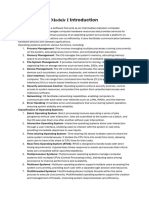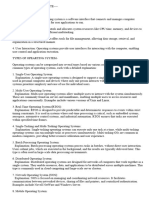What is a Kernel?
The kernel is a core component of an operating system that manages system resources and
facilitates communication between hardware and software. It serves as a bridge between
applications and the actual data processing performed at the hardware level.
Key Functions of a Kernel:
1. **Process Management**: Handles the creation, scheduling, and termination of processes. It
ensures efficient execution and multitasking by allocating CPU time to various processes.
2. **Memory Management**: Manages the system's memory, including RAM and cache. It keeps
track of each byte in a computer's memory and allocates memory to processes as needed, ensuring
there is no overlap.
3. **Device Management**: Facilitates communication between the system and hardware devices.
The kernel provides drivers that allow the operating system and applications to interact with
hardware components like printers, disks, and keyboards.
4. **File System Management**: Manages file operations and storage. It handles the reading,
writing, and organizing of data on storage devices, ensuring data integrity and security.
5. **Security and Access Control**: Enforces security policies and access controls, ensuring that
unauthorized access to system resources is prevented. It manages user permissions and system
authentication.
6. **Interrupt Handling**: Responds to interrupts from hardware devices. The kernel ensures that
critical tasks are handled immediately by prioritizing interrupts over other processes.
7. **Networking**: Manages network communications, enabling data exchange between computers
over various types of networks.
Types of Kernels:
�1. **Monolithic Kernel**: A single large process running entirely in a single address space. It
includes all the essential services like device drivers, file system management, and system server
calls.
2. **Microkernel**: A smaller kernel that only includes basic services like communication between
processes and basic hardware management. Other services like device drivers and file systems run
in user space.
3. **Hybrid Kernel**: Combines elements of both monolithic and microkernel architectures. It aims to
provide the performance benefits of a monolithic kernel with the modularity and stability of a
microkernel.
4. **Exokernel**: A minimalistic kernel design that gives more direct access to hardware resources.
It aims to remove abstractions and allow applications to manage hardware directly for better
performance.
Importance of the Kernel:
The kernel is crucial for system stability, efficiency, and security. It ensures that hardware resources
are used effectively and that applications can run smoothly without interfering with each other. By
managing system resources and enforcing security policies, the kernel plays a vital role in
maintaining the overall integrity and performance of an operating system.
In summary, the kernel is the heart of an operating system, providing essential services that enable
the software to interact with the hardware efficiently and securely.
For more information, please refer to detailed technical resources or operating system textbooks.























































































